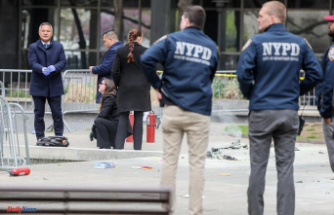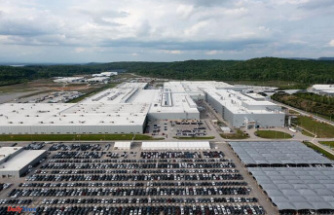If you cycle along the Hudson from the north towards downtown, you can feel the landscape suddenly collapsing at 59th Street. Suddenly, Riverside Park, with its broad sycamore-lined promenade as a buffer between the riverside bike path and the city freeway that brutalist city architect Robert Moses carved between Manhattan and the water, disappears.
The view also changes to the right. After the small marina on 79th Street, the old piers now jut out into the river like the fringes of a leather jacket. A good 30 of them line up on Manhattan's West Bank before ending directly across from Ground Zero.
There, the Hudson River Greenway joins a waterfront promenade lined with park benches and lanterns that winds around Battery Park City, a collection of high-rise apartment buildings that were built in the 1970s on top of the World Trade Center excavation dumped into the river.
From here, past the Statue of Liberty, you can see what is now considered New York Harbor: the forest of cranes unloading the large container ships on the New Jersey shore. Most of them are robots, controlled by an invisible hand in some invisible circuit center. This view reminds the cyclist what the 30 piers he just passed were still used for almost 60 years ago - before they were greened and turned into sports and entertainment facilities.
The era of the dock workers' quarters came to an end at the beginning of the 1960s. And with the departure of the port that had fueled New York's prosperity since the city's founding as a trading post in the 17th century, New York's shores began a slow decline.
Anyone who was in New York in the 1970s or 1980s knew that the rivers were not a place to go unless you had to. The crumbling piers were roosting spots for the homeless and a stomping ground for cheap prostitution. There were wild drug parties there and whenever there was a deal to be made or a body to be disposed of in a gangster movie, it was done by the water. The water was not a place for strolling, cycling or jogging.
In the 1980s, nobody would have thought of going to the river. When you lived in New York back then, you didn't really think that the city was actually on the water.
It was a strange state. Because New York has an incredible 1000 kilometers of waterfront - along the Hudson, the East River and the Harlem River, north and south of Brooklyn and Queens, along the entire southern edge of the Bronx, not to mention smaller bodies of water like the Gowanus Canal, the runs through Brooklyn.
But the city has always had a pragmatic and rarely romantic relationship with its shores. The famous scene from the Woody Allen film "Manhattan", in which he sits under the Queensboro Bridge on the East River with Mia Farrow, admires the city lights and raves that New York is the most beautiful city in the world, remained Runaway.
More realistic was Ridley Scott's "Black Rain" from 1989, where illegal motorcycle racing takes place in the opening scene under the Brooklyn Bridge between car lots and garbage dumps.
The rivers have always been usable areas, industrial areas. It wasn't until the 2000s and the reign of Mayor Michael Bloomberg that New York discovered its shores for its citizens. Entrepreneur Bloomberg saw the many vacant lots along the waterfront as untapped opportunities. He saw limitless building and profit opportunities.
Of course, the banks first had to be made attractive before there could be incentives to invest in them. The greening of the Hudson River Greenway, the narrow strip between the water and the freeway from Battery Park City to the northern tip of Manhattan, was one such project. The phenomenal park under the Brooklyn Bridge, into which hundreds of millions of public-private partnerships flowed, is another.
The orientation towards the water was a resounding success. The geography of the city has changed dramatically in the minds of New Yorkers in recent years.
New York has gained hundreds of miles of space: room to play, to picnic, to skate, to bike, to practice the saxophone without disturbing the neighbors, to lie in a hammock and look out at the New Jersey shore, to to fish, to barbecue - and for teenagers to do things that parents shouldn't see.
Bloomberg's vision of opening up the wasteland by the water for large-scale building projects has at least partly worked out. On the East River in particular, from Williamsburg all the way up to Long Island City, whole test-tube cities have grown out of glass towers for luxury apartments.
But in all this rediscovered enthusiasm for the shores came October 2012 Superstorm Sandy, thundering roaring up the Atlantic coast. The confluence of three hurricanes just a dozen miles east of Manhattan made the city painfully aware of what it means to live by the water in times of climate change.
In the afternoon, while dark clouds were gathering, the water level on all banks rose to the brink of overflowing. When the winds came in the evening and centuries-old trees in Central Park snapped like they were matchsticks, the dams no longer held up anywhere.
The Westside Highway was submerged in no time, as were the main tunnels connecting Manhattan, Brooklyn and New Jersey. Flash floods tumbled like waterfalls into the subway stations. No basement in lower Manhattan stays dry. Red Hook, Brooklyn's last longshoreman's neighborhood, was inundated by a flash flood. Half of Manhattan and much of Brooklyn were without power for a week.
Sandy made painfully clear to every New Yorker what climate activists had been preaching for decades. The water-washed metropolis is more vulnerable to the consequences of climate change than any other in North America. Projections for the next 30 years assume that 25 percent of the city's area will be prone to regular flooding. Around 800,000 New Yorkers live in areas that will no longer be reliably livable after 2050.
Ever since Sandy, New York has known that the future, like the past, is tied to water. The fact that the city has ignored its connection to water for so long is proving to be a fatal omission. Now New York can no longer deny its dependence on water.
After Sandy, many clever minds in New York understood that. People in the city understood that the survival of the city and the focus on water belong together. For example, immediately after Sandy, New York announced a competition to redesign the banks of lower Manhattan. The winning company, Rebuild by Design, produced a plan that included not only protecting vital infrastructure, but creating spacious parks and recreational areas that can serve as flood defenses.
In other places, the mills grind more slowly. Plans to build a giant flood barrier at the entrance to New York Bay are still awaiting subsidies from Washington. And in Brooklyn, construction is happily continuing near the waterfront.
Ever since Sandy, you've had conflicting feelings when you're standing in Battery Park and looking out over New York Bay. It's still a sublime sight when the Staten Island Ferry passes the Statue of Liberty. One inevitably thinks of the millions of immigrants who came to New York across the sea and made this city what it is.
One thinks of the waters that flow together here from all directions and give life to one of the greatest metropolises in the world. But at the same time you have to think about the destructive power of these waters, of which Sandy gave us just a taste.
It is clear at this moment that New York only has a future in the 21st century if it is reconciled with these water masses that form a wild, unpredictable whirlpool here, at the city's birthplace. And New York has no more time to lose.
The text is an abridged excerpt from the book “Lesereise New York” by Sebastian Moll, Picus Verlag, which has just been published, 132 pages, 16 euros.












